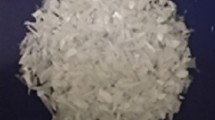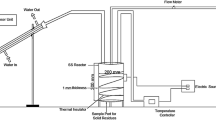Abstract
The widespread usage of plastic grocery bags, as well as their non-biodegradability, has turned out to be a stern reason for waste generation. With regard to plastic grocery bag disposal, pyrolysis is an encouraging solution that addresses the energy crisis issue as well. This study examined the interactive influences of pyrolysis temperature, residence time, and nitrogen flow for plastic grocery bag pyrolysis to optimize waste plastic oil yield by the Grey–Fuzzy–Taguchi method. Additionally, mass–energy assessment and characterization were done for the waste plastic oil, extracted at the optimal parametric condition. The optimal parametric combination was: temperature 400 °C, time 360 min, and nitrogen flow rate 20 ml/min. The liquid yield at optimal condition was 78.57%, and a minimal error (2.53%) between the predicted and experimental grey fuzzy grade was observed. The oil achieved at optimal condition showed a high hydrocarbon content with a higher heating value of 46,685 kJ/kg. The values of mass ratio, energy ratio, energy efficiency, and energy consumption ratio for the liquid oil were 0.79, 0.89, 0.63, and 0.47, respectively, which indicate the energy favorability for plastic grocery bag pyrolysis. FT-IR results demonstrated mainly the existence of alkene and alkane functional groups in the waste plastic oil. GC–MS results revealed that the oil contains mainly light and middle fractions of 26.4% and 62.7%, respectively, with a smaller proportion (10.9%) of heavy fraction. Finally, the optimum parametric combination can be considered a useful condition for extracting quality fuel from plastic grocery bags.
Graphical abstract








Similar content being viewed by others
Data availability
Data are available on request from corresponding authors. However, the data are not publicly available as that could compromise the research participant privacy/consent.
References
Ahmad I, Khan MI, Khan H, Ishaq M, Tariq R, Gul K, Ahmad W (2014) Pyrolysis study of polypropylene and polyethylene into premium oil products. Int J Green Energy 12:663–671. https://doi.org/10.1080/15435075.2014.880146
Awale A, Inamdar K (2020) Multi-objective optimization of high-speed turning parameters for hardened AISI S7 tool steel using grey relational analysis. J Braz Soc Mech Sci Eng. https://doi.org/10.1007/s40430-020-02433-z
Bharathy S, Gnanasikamani B, Lawrence KR (2019) Investigation on the use of plastic pyrolysis oil as alternate fuel in a direct injection diesel engine with titanium oxide nanoadditive. Environ Sci Pollut Res 26:10319–10332. https://doi.org/10.1007/s11356-019-04293-0
Bhowmik A, Biswas A (2021) Wear resistivity of Al7075/6wt%SiC composite by using grey-fuzzy optimization technique. SILICON. https://doi.org/10.1007/s12633-021-01160-x
Cai J, He Y, Yu X, Banks SW, Yang Y, Zhang X, Yu Y, Liu R, Bridgwater AV (2017) Review of physicochemical properties and analytical characterization of lignocellulosic biomass. Renew Sustain Energy Rev 76:309–322. https://doi.org/10.1016/j.rser.2017.03.072
Central Pollution Control Board (CPCB) (2018) Annual report on plastic waste management rule. CPCB Ministry of Environment, Forest and Climate Change, Govt. of India, Delhi. http://cpcb.nic.in/uploads/plasticwaste/Annual_Report_2017-18_PWM.pdf
Dauvergne P (2018) Why is the global governance of plastic failing the oceans? Glob Environ Chang 51:2–31. https://doi.org/10.1016/j.gloenvcha.2018.05.002
Dey S, Deb M, Das PK (2019) Application of fuzzy-assisted grey Taguchi approach for engine parameters optimization on performance-emission of a CI engine. Energy Sour Part A Recover Util Environ Eff. https://doi.org/10.1080/15567036.2019.1697392
EUNOMIA (2018) Plastic Packaging. Shredding Light on the UK Data- A Report by Eunomia Research & Consulting Ltd, Bristol, UK. https://www.eunomia.co.uk/reports-tools/plastic-packaging-shedding-light-on-the-uk-data/ (Accessed on 20th December 2021)
Geo VE, Sonthalia A, Aloui F, Js FJ (2018) Study of engine performance, emission and combustion characteristics fueled with diesel-like fuel produced from waste engine oil and waste plastics. Front Environ Sci Eng. https://doi.org/10.1007/s11783-018-1063-6
Guo F, Wang X, Yang X (2017) Potential pyrolysis pathway assessment for microalgae-based aviation fuel based on energy conversion efficiency and life cycle. Energy Convers Manage 132:272–280. https://doi.org/10.1016/j.enconman.2016.11.020
Insura N, Onwudili JA, Williams PT (2010) Catalytic pyrolysis of low-density polyethylene over alumina-supported noble metal catalysts. Energy Fuels 24:4231–4240. https://doi.org/10.1021/ef100227f
Jozić S, Bajić D, Celent L (2015) Application of compressed cold air cooling: achieving multiple performance characteristics in end milling process. J Clean Prod 100:325–332. https://doi.org/10.1016/j.jclepro.2015.03.095
Kalargaris I, Tian G, Gu S (2017) Experimental evaluation of a diesel engine fuelled by pyrolysis oils produced from low-density polyethylene and ethylene–vinyl acetate plastics. Fuel Process Technol 161:125–131. https://doi.org/10.1016/j.fuproc.2017.03.014
Khalife E, Tabatabaei M, Demirbas A, Aghbashlo M (2017) Impacts of additives on performance and emission characteristics of diesel engines during steady state operation. Progr Energy Combust Sci 59:32–78. https://doi.org/10.1016/j.pecs.2016.10.001
Khamparia A, Pandey B, Pandey DK, Gupta D, Khanna A, de Albuquerque VHC (2020) Comparison of RSM, ANN and fuzzy logic for extraction of oleonolic acid from ocimum sanctum. Comput Ind 117:103200. https://doi.org/10.1016/j.compind.2020.103200
Lin JL, Lin CL (2005) The use of grey-fuzzy logic for the optimization of the manufacturing process. J Mater Process Technol 160:9–14. https://doi.org/10.1016/j.jmatprotec.2003.11.040
Mastral FJ, Esperanza E, Garcia P, Juste M (2002) Pyrolysis of high-density polyethylene in a fluidised bed reactor. Influence of the temperature and residence time. J Anal Appl Pyrolysis 63:1–15. https://doi.org/10.1016/S0165-2370(01)00137-1
Miskolczi N, Bartha L, Deák G, Jóver B, Kalló D (2004) Thermal and thermo-catalytic degradation of high-density polyethylene waste. J Anal Appl Pyrol 72:235–242. https://doi.org/10.1016/j.jaap.2004.07.002
Muhammad I, Makwashi N, Manos G (2018) Catalytic degradation of linear low-density polyethylene over hy-zeolite via pre-degradation method. J Anal Appl Pyrol. https://doi.org/10.1016/j.jaap.2018.11.025
Mumbach GD, Alves JLF, Silva JCGD, Sena RFD, Marangoni C, Machado RAF, Bolzan A (2019) Thermal investigation of plastic solid waste pyrolysis via the deconvolution technique using the asymmetric double sigmoidal function: determination of the kinetic triplet, thermodynamic parameters, thermal lifetime and pyrolytic oil composition for clean energy recovery. Energy Convers Manage 200:112031. https://doi.org/10.1016/j.enconman.2019.112031
Onwudili JA, Insura N, Williams PT (2009) Composition of products from the pyrolysis of polyethylene and polystyrene in a closed batch reactor: effects of temperature and residence time. J Anal Appl Pyrol 86:293–303. https://doi.org/10.1016/j.jaap.2009.07.008
Our World in Data (2018) Plastic Pollution. https://ourworldindata.org/plastic-pollution (Accessed on 20th December 2021)
Pan R, Martins MF, Debenest G (2021) Pyrolysis of waste polyethylene in a semi-batch reactor to produce liquid fuel: Optimization of operating conditions. Energy Convers Manage 237:114114. https://doi.org/10.1016/j.enconman.2021.114114
Panda A, Sahoo AK, Rout AK (2016) Multi-attribute decision making parametric optimization and modeling in hard turning using ceramic insert through grey relational analysis: a case study. Decis Sci Lett 5:581–592. https://doi.org/10.5267/j.dsl.2016.3.001
Pandey AK, Gautam GD (2018) Grey relational analysis-based genetic algorithm optimization of electrical discharge drilling of Nimonic-90 superalloy. J Braz Soc Mech Sci Eng 40:117. https://doi.org/10.1007/s40430-018-1045-4
Panithasan MS, Gopalakichenin D, Venkadesan G, Veeraraagavan S (2019) Impact of rice husk nanoparticle on the performance and emission aspects of a diesel engine running on blends of pine oil-diesel. Environ Sci Pollut Res 26:282–291. https://doi.org/10.1007/s11356-018-3601-y
Paramasivam B (2020) Fuzzy prediction and RSM optimization of CI engine performance analysis: aegle marmelos non-edible seed cake pyrolysis oil as a diesel alternative. Energy Sour Part A Recover Util Environ Eff. https://doi.org/10.1080/15567036.2020.1773971
Quesada L, Pérez A, Godoy V, Peula FJ, Calero M, Blázquez G (2019a) Optimization of the pyrolysis process of a plastic waste to obtain a liquid fuel using different mathematical models. Energy Convers Manage 188:19–26. https://doi.org/10.1016/j.enconman.2019.03.054
Quesada L, Calero M, Martín-Lara MA, Pérez A, Blázquez G (2019b) Characterization of fuel produced by pyrolysis of plastic film obtained of municipal solid waste. Energy 186:115874. https://doi.org/10.1016/j.energy.2019b.115874
Rodríguez-Luna L, Bustos-Martínez D, Valenzuela E (2021) Two-step pyrolysis for waste HDPE valorization. Process Saf Environ Prot 149:526–536. https://doi.org/10.1016/j.psep.2020.11.038
Roy S, Das AK, Banerjee R (2016) Grey-Fuzzy Taguchi approach for multi-objective optimization of performance and emission parameters of a single cylinder CRDI engine coupled with EGR. Int J Automot Technol 17:1–12. https://doi.org/10.1007/s12239-016-0001-5
Saha D, Sinha A, Pattanayak S, Roy B (2021a) Pyrolysis kinetics and thermodynamic parameters of plastic grocery bag based on thermogravimetric data using iso-conversional methods. Int J Environ Sci Technol. https://doi.org/10.1007/s13762-020-03106-z
Saha D, Sinha A, Roy B (2021b) Critical insights into the effects of plastic pyrolysis oil on emission and performance characteristics of CI engine. Environ Sci Pollut Res 28:44598–44621. https://doi.org/10.1007/s11356-021-14919-x
Sharma BK, Moser BR, Vermillion KE, Doll KM, Rajagopalan N (2014) Production, characterization and fuel properties of alternative diesel fuel from pyrolysis of waste plastic grocery bags. Fuel Process Technol 122:79–90. https://doi.org/10.1016/j.fuproc.2014.01.019
Sharuddin SDA, Abnisa F, Daud WMAW, Aroua MK (2016) A review on pyrolysis of plastic wastes. Energy Convers Manage 115:308–326. https://doi.org/10.1016/j.enconman.2016.02.037
Sharuddin SDA, Abnisa F, Daud WMAW, Aroua MK (2017) Energy recovery from pyrolysis of plastic waste: Study on non-recycled plastics (NRP) data as the real measure of plastic waste. Energy Convers Manage 148:925–934. https://doi.org/10.1016/j.enconman.2017.06.046
Singh RK, Ruj B, Sadhukhan AK, Gupta P (2019) Thermal degradation of waste plastics under non-sweeping atmosphere: part 1: effect of temperature, product optimization, and degradation mechanism. J Environ Manage 239:395–406. https://doi.org/10.1016/j.jenvman.2019.03.067
Singh RK, Ruj B, Sadhukhan AK, Gupta P (2020) Thermal degradation of waste plastics under non-sweeping atmosphere: part 2: effect of process temperature on product characteristics and their future applications. J Environ Manage 261:110112. https://doi.org/10.1016/j.jenvman.2020.110112
Soares C (2008) Gas turbine fuel systems and fuels. Gas Turbines. https://doi.org/10.1016/b978-075067969-5.50012-0
The world counts (2021) https://www.theworldcounts.com/challenges/planet-earth/waste/plastic-bags-used-per-year/story (Accessed on 20th December 2021)
Tiikma L, Tamvelius H, Luik L (2007) Coprocessing of heavy shale oil with polyethylene waste. J Anal Appl Pyrol 79:191–195. https://doi.org/10.1016/j.jaap.2006.12.029
Vanapalli KR, Bhattacharya J, Samal B, Chandra S, Medha I, Dubey BK (2020) Optimized production of Single-use plastic-Eucalyptus wood char composite for application in soil. J Clean Prod 79:191–195. https://doi.org/10.1016/j.jclepro.2020.123968
Venkatesan H, Sivamani S, Bhutoria K, Vora HH (2018) Experimental study on combustion and performance characteristics in a DI CI engine fuelled with blends of waste plastic oil. Alex Eng J 57:2257–2263. https://doi.org/10.1016/j.aej.2017.09.001
Vieira FR, Luna CMR, Arce GLAF, Ávila I (2020) Optimization of slow pyrolysis process parameters using a fixed bed reactor for biochar yield from rice husk. Biomass Bioenerg 132:105412. https://doi.org/10.1016/j.biombioe.2019.105412
Wirawan RP, Farizal (2019) Plastic waste pyrolysis optimization to produce fuel grade using factorial design. E3S Web of Conferences 125:13005. https://doi.org/10.1051/e3sconf/201912513005
Zhang Y, Ji G, Ma D, Chen C, Wang Y, Wang W, Li A (2020) Exergy and energy analysis of pyrolysis of plastic wastes in rotary kiln with heat carrier. Process Saf Environ Prot 142:203–211. https://doi.org/10.1016/j.psep.2020.06.021
Acknowledgements
The authors are grateful to the late Dr. Abhijit Sinha, former Assistant professor of the National Institute of Technology, Mizoram, who although no longer with us, continues to inspire us to date by his dedication toward this research field. The authors would like to acknowledge CSIR-Central Electrochemical Research Institute (CECRI, Karaikudi) for the support to conduct elemental, FT-IR, and GC-MS analysis of the samples. The authors are thankful to Labtronics, Ambala, Haryana, India, for their support to evaluate the HHV of the samples. The authors are also grateful to the National Institute of Technology, Mizoram, for providing all other research facilities.
Funding
No funding was received for conducting this study.
Author information
Authors and Affiliations
Contributions
DS: Investigation, Data curation, Methodology, Writing—original draft. JG: Conceptualization, Visualization. BR: Supervision, Writing—review and editing. AKP: Supervision. Writing—review and editing. AB: Formal analysis, Visualization. SP: Formal analysis, Visualization.
Corresponding author
Ethics declarations
Conflict of interest
The authors declare that they have no conflict of interest.
Additional information
Publisher's Note
Springer Nature remains neutral with regard to jurisdictional claims in published maps and institutional affiliations.
Rights and permissions
About this article
Cite this article
Saha, D., Gurung, J., Roy, B. et al. Optimizing pyrolysis process parameters of plastic grocery bag, with mass–energy assessment and characterization of oil at optimal condition. Clean Techn Environ Policy 24, 1927–1944 (2022). https://doi.org/10.1007/s10098-022-02298-x
Received:
Accepted:
Published:
Issue Date:
DOI: https://doi.org/10.1007/s10098-022-02298-x




